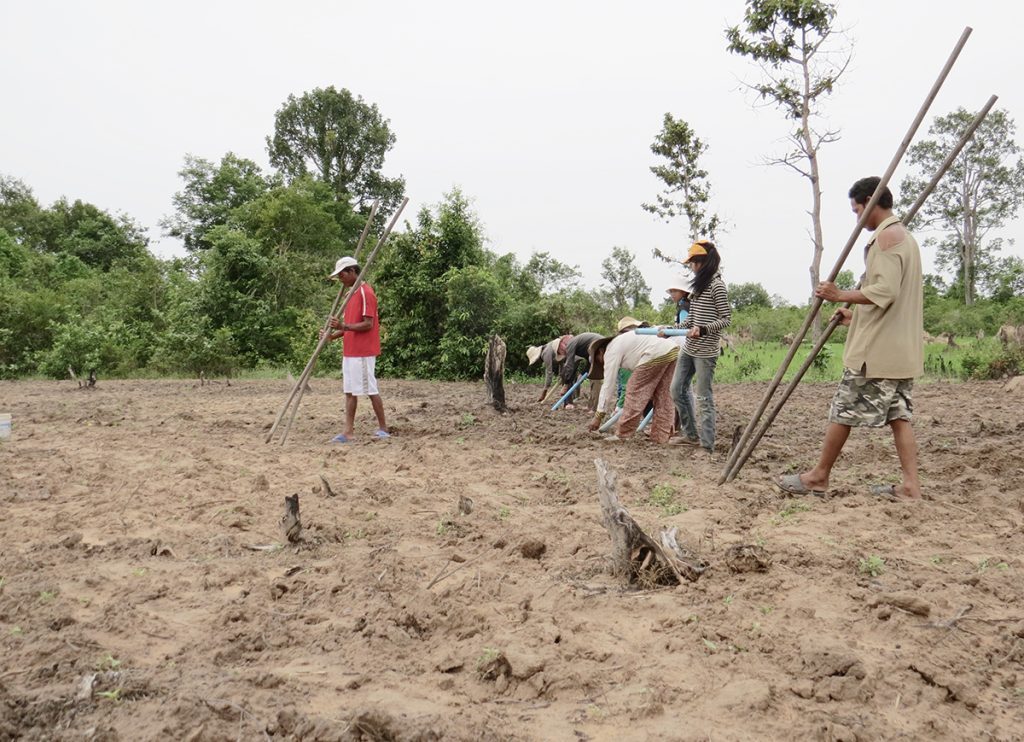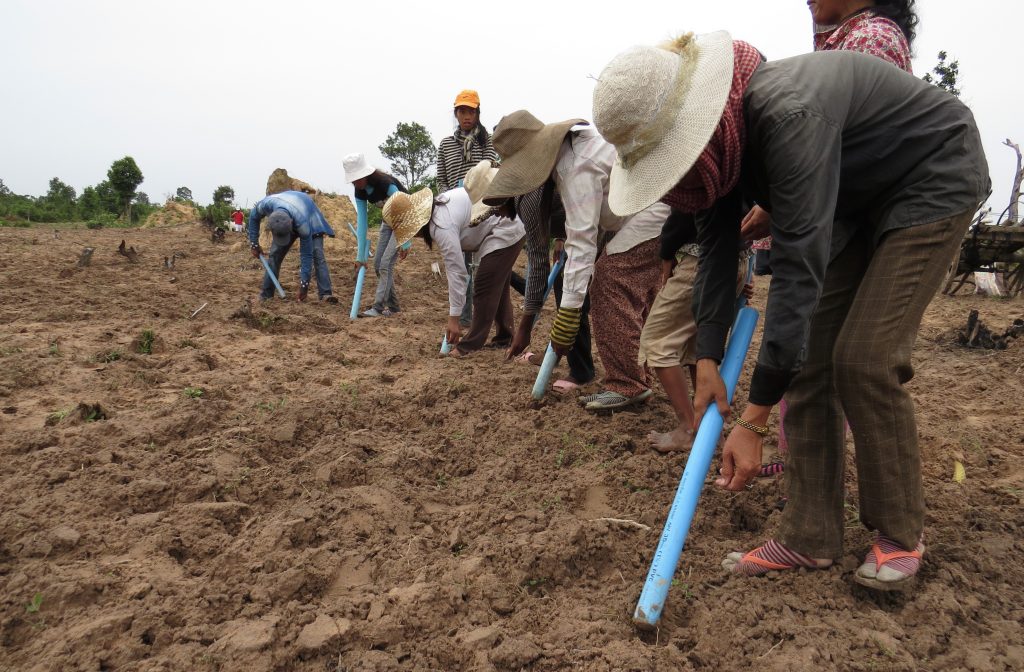វិធីដាំដុះស្រូវតាមបែបបុរាណមានច្រើនយ៉ាង អាស្រ័យទៅលើសណ្ឋានដីផង និងអាស្រ័យទៅលើពូជស្រូវផង។ ស្រូវវស្សា គេច្រើនស្ទូង ឬព្រោះក្នុងស្រែលើកភ្លឺឱ្យមានទឹកដក់គ្រប់គ្រាន់។ រីឯស្រូវធ្ងន់ជំពូកខ្លះ ពុំងាយឱ្យផលមានដូចជា ស្រូវឡើងទឹក ឬស្រូវប្រដេញទឹក គេច្រើនស្ទូង ឬព្រោះក្នុងស្រែជម្រៅ ឬស្រែបឹង ឬស្ទូងក្នុងត្រពាំងមានទឹកជ្រៅដក់នៅយូរខែ។
ដោយឡែក ស្រូវមួយបែបទៀតហៅថា “ស្រូវចម្ការ” គេច្រើនដាំដុះក្នុងចម្ការថ្មីទើបកាប់ហែករើសម្អាតព្រៃ ឬបុសចាស់ធ្លាប់ដាំដុះម្តងជាពីរដង តែនៅសេសសល់គល់ឈើ ឬឫសឈើភ្ជួរមិនកើត គេច្រើនប្រើវិធី “ច្រឹង”។ របៀបធ្វើស្រូវចម្ការដោយច្រឹង ឬបុកដីដាំនេះ ក៏ជាទំនៀមរបស់ជនជាតិដើមភាគតិចនៅភាគឦសាន្តដែរ ហើយក្នុងភាសាជនជាតិព្រៅហៅថា “ឆ្យាមូចួយ”។
រដូវដែលគេអាចចាប់ផ្តើមច្រឹងដាំស្រូវបាន គឺក្នុងរង្វង់ខែជេស្ឋ ឬអាសាឍ ពោលគឺបន្ទាប់ពីធ្លាក់ភ្លៀងសើមដីម្តងជាពីរដង។ ចំពោះចម្ការដែលធ្លាប់ច្រឹងដាំបែបនេះពី ៣ឆ្នាំទៅ៤ ឆ្នាំជាប់ៗគ្នា គេអាចភ្ជួរដាំបានដោយអន្លើនៅឆ្នាំបន្តបន្ទាប់ ព្រោះគល់ឈើនឹងងាប់ ឬពុកផុយរលស់ខ្លះ។ ប៉ុន្តែចំពោះជនជាតិដើមភាគតិច គេតែងប្តូរកន្លែងដាំស្រូវពីចម្ការមួយទៅចម្ការ ក្នុងរង្វង់រវាងពី២ឆ្នាំ ទៅ៣ឆ្នាំ ហៅថា “ចម្ការវិលជុំ” ឬអ្នកខ្លះហៅថា “ចម្ការព្រៃដុត”។ របៀបធ្វើចម្ការបែបនេះ ក៏ជាទំនៀមរបស់ជនជាតិដើមប្រកាន់យក ហើយដែលគេតែងសម្គាល់ឃើញជាទូទៅរហូតមក។
ចំពោះវិធីច្រឹង ដំបូងដៃគេគ្រាន់តែយកឈើ ឬឫស្សីដែលមានទំហំប្រហែលប៉ុនកដៃ ឬតូចជាងនេះបន្តិច ល្មមងាយស្រួលក្តាប់កាន់ ប្រវែងប្រហែលពី ២ម៉ែត្រ ទៅ២ម៉ែត្រកន្លះ សម្រួចខាងគល់ឱ្យស្រួចហៅថា “ឈើច្រឹង”។ លុះដល់ថ្ងៃដាំស្រូវ ត្រូវមានមនុស្សម្នាក់កាន់ឈើច្រឹងបុកជាអន្លង់សម្រាប់ដាក់គ្រាប់ពូជ ដែលគេច្រើនហៅថា “អ្នកច្រឹង”។ អ្នកច្រឹងតែងកាន់ឈើច្រឹងក្នុងដៃទាំងសងខាង បុកអន្លង់ជម្រៅប្រហែល១ថ្នាំងដៃ ឬជ្រៅជាងនេះបន្តិច ដោយដើរច្រឹងទៅមុខ ឬថយក្រោយក៏បាន ហើយសកម្មភាពនេះក៏ហៅថា “ច្រឹង” ដែរ។
ការច្រឹងដាំស្រូវចម្ការ គេតែងច្រឹងតាមចន្លោះគល់ឈើ ឬជុំវិញដំបូកត្រង់ចំណែកដីណាទំនេរ ក្នុងគម្លាតប្រហែល៣ទៅ៤ តឹក ល្មមស្រូវលូតលាស់បែកគុម្ពបាន។ ជាទូទៅអ្នកច្រឹង ភាគច្រើនជាមនុស្សប្រុសពេញកម្លាំង ចំណែកឯអ្នកដាក់គ្រាប់ពូជច្រើនជាមនុស្សស្រី ឬក្មេងដែលអាចជំនួសដៃជើងក្នុងកិច្ចការនេះ។ អ្នកច្រឹងម្នាក់ អាចច្រឹងឱ្យអ្នកដាក់គ្រាប់ដាំបានប្រហែល៤ ទៅ៥ នាក់។ ដូច្នេះប្រសិនបើផ្ទៃដីចម្ការធំ គេច្រើនប្រវាស់ដៃគ្នា ពោលគឺជួយយកអាសារគ្នាម្តងម្នាក់ ដោយត្រូវរកអ្នកច្រឹង៤ ទៅ៥នាក់ និងអ្នកដាំប្រហែល១០ ទៅ២០នាក់។
ទិដ្ឋភាពនៃការច្រឹងដាំស្រូវនេះ ក្រៅពីមានមនុស្សច្រើនជួយធ្វើការរួមគ្នា សប្បាយរីករាយ គេសង្កេតឃើញថាបើក្នុងករណីច្រឹងមិនទាន់ អ្នកដាំខ្លះយកបំពង់ដាក់គ្រាប់ពូជនោះវាយកែងជើងអ្នកច្រឹង ទុកជាល្បែងផ្ទាន់លេងសប្បាយផង និងក្រើនរំឭកឱ្យអ្នកច្រឹងញាប់ដៃថែមទៀត។ ប្រការមួយទៀត ដែលគេសម្គាល់ឃើញ បើមានអន្លង់ណានៅកៀកជិតគ្នាគេហៅថា “អន្លង់ពរកូន”។ អន្លង់ពរកូននេះ គេច្រើនរំលងចោលមួយ លៃយកអន្លង់ណាដែលមានគម្លាតល្មមពីអន្លង់ដទៃទៀត។ គេបន្តច្រឹង និងដាំតាមក្រោយគ្នាបែបនេះ ឱ្យហើយរួចរាល់ក្នុងពេលមួយថ្ងៃ ឬពីរថ្ងៃ ដើម្បីឱ្យស្រូវដុះលូតលាស់ល្អព្រមគ្នា។
ចំពោះពូជស្រូវចម្ការដែលគេនិយមដាំមានដូចជា ពូជនាងឧក ឬពូជនាងកួន (នាងកួយ?) និងពូជខ្លះទៀតដែលជាពូជស្រូវស្រាល “ឆាប់ចេញ” ឬអ្នកស្រុកតំបន់អង្គរខ្លះហៅថា “ឆាប់លេច” ក្នុងរវាង៤ ទៅ៥ខែ។ រីឯជនជាតិដើមភាគតិចព្រៅមានពូជស្រូវដែលតែងច្រឹងដាំបានដូចជា កាវ៉ែត ប្លីត ល្ខន ហ្កល ត្រាញ់ កាស៊ី ។ល។ ពូជស្រូវដែលត្រូវយកមកដាំនោះ គេពុំចាំបាច់ត្រាំទឹកដូចយកទៅសាបក្នុងថ្នាលឡើយ។ ក្នុងពេលដាំ គេអាចលាយគ្រាប់ដំណាំផ្សេងៗទៀតបានដូចជា ពោត សណ្តែក ត្រសក់ ឪឡឹក ត្រឡាច ម្ទេស ល្ពៅជាដើម។ ប៉ុន្តែការលាយគ្រាប់ពូជដំណាំរួមផ្សំផ្សេងៗនោះ គឺតិចភាគបំផុតបើធៀបនឹងគ្រាប់ស្រូវ។ ហេតុដូច្នេះហើយ ទើបគេតែងសង្កេតឃើញក្នុងស្រូវចម្ការ តែងមានដំណាំរួមផ្សំផ្សេងៗដុះលាយឡំ និងឱ្យផលជាប់រដឹកជាហូរហែ។
ក្នុងថ្ងៃដាំគេយកគ្រាប់ពូជច្រកបំពង់ឫស្សី (សព្វថ្ងៃប្រើបំពង់ជ័រ) ប្រវែងប្រហែលកន្លះម៉ែត្រ ឬ៨តឹក។ បំពង់ឫស្សីនោះទំហំប៉ុនកដៃ ហើយផ្នែកម្ខាងត្រូវទុកថ្នាំង (បើបំពង់ជ័រគេច្នៃធ្វើឆ្នុកម្ខាង) រាំងកុំឱ្យជ្រុះគ្រាប់ពូជផង និងទុកជាផ្នែកសម្រាប់រុញដីលុបរណ្តៅវិញ។ ក្នុងរយៈពេល៣ ទៅ៤ថ្ងៃ គ្រាប់ស្រូវនោះនឹងដុះឡើង រហូតលូតបានប្រមាណ២ ទៅ៣ តឹក គេត្រូវបំបែកគុម្ពមានដើមស្រូវច្រើន ទៅដាំជួសចន្លោះណា ឬក្បែរគុម្ពដែលមិនសូវដុះ។ គេច្រើនបំបែកស្រូវនៅពេលមេឃកំពុងភ្លៀង ដ្បិតដើម្បីកុំឱ្យស្រូវដែលទើបបំបែកដាំនោះស្វិត ឬងាប់។ បន្ទាប់ពីបំបែកហើយអស់គេត្រូវទៅរវាំងមើលស្រូវនោះជារឿយៗ បង្ការគោក្របីមកស៊ីបំផ្លាញ រហូតដល់ស្រូវចេញ និងទុំល្មមប្រមូលផលទើបចប់ភារកិច្ចស្រូវចម្ការ៕
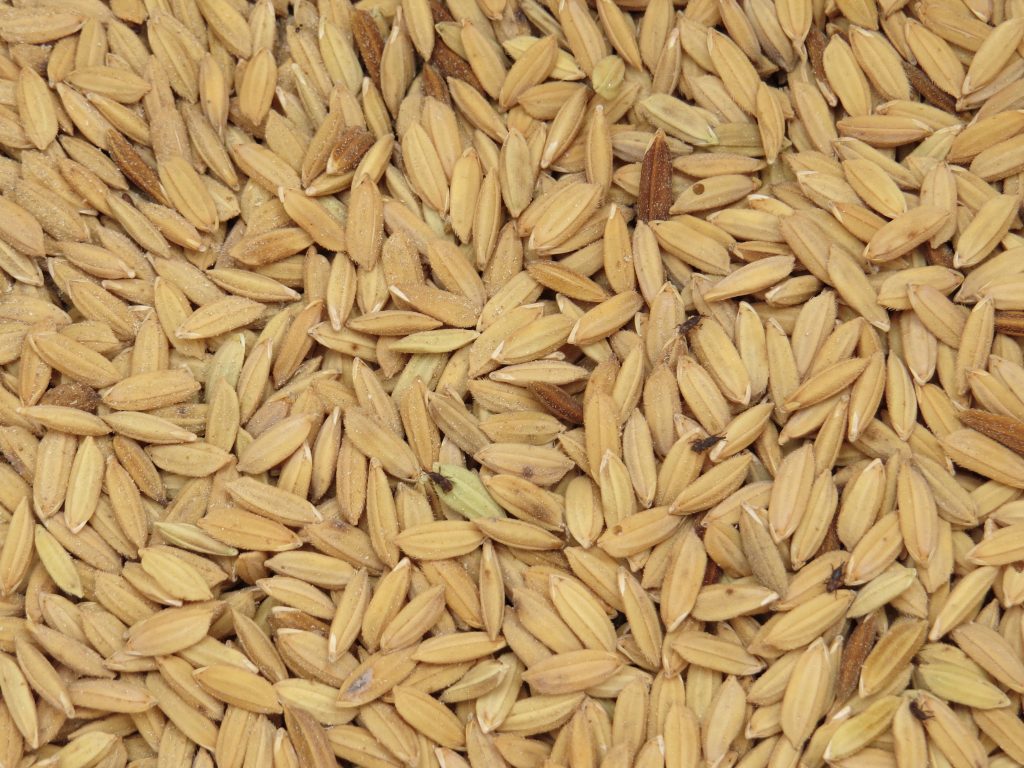
គ្រាប់ពូជស្រូវត្រូវដាំ 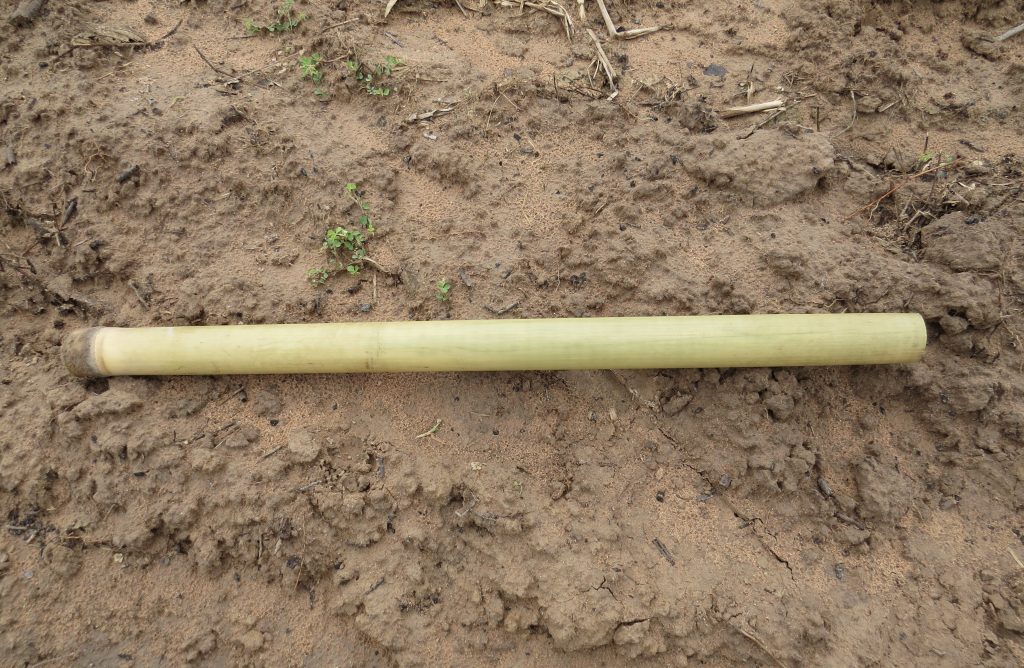
បំពង់ដាក់គ្រាប់ពូជដាំ 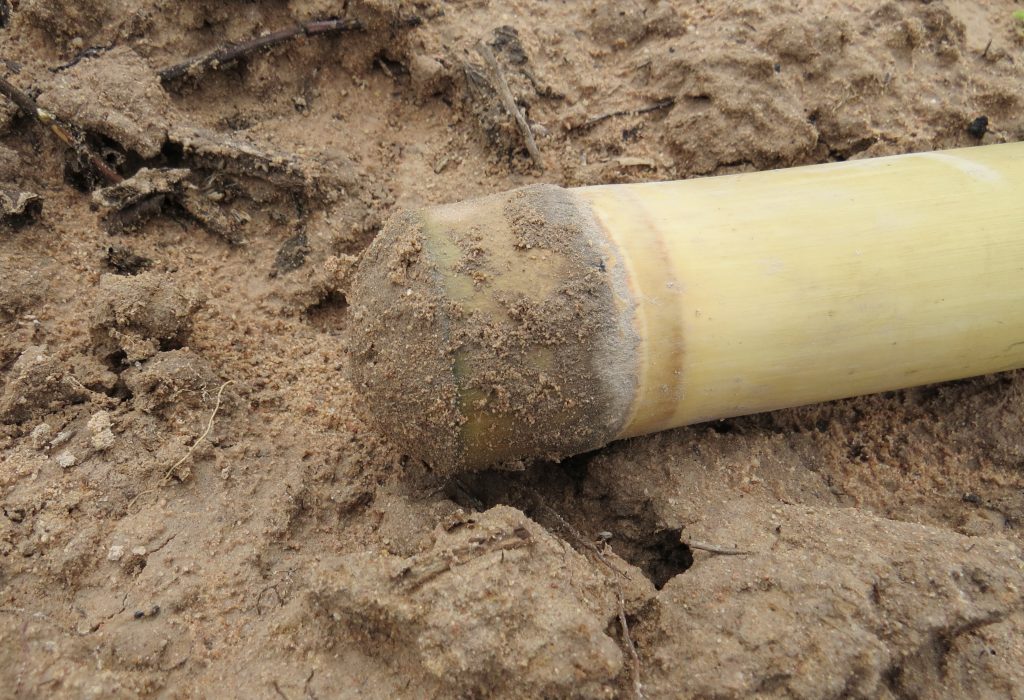
ផ្នែកខាងថ្នាំងទុកលុបដី
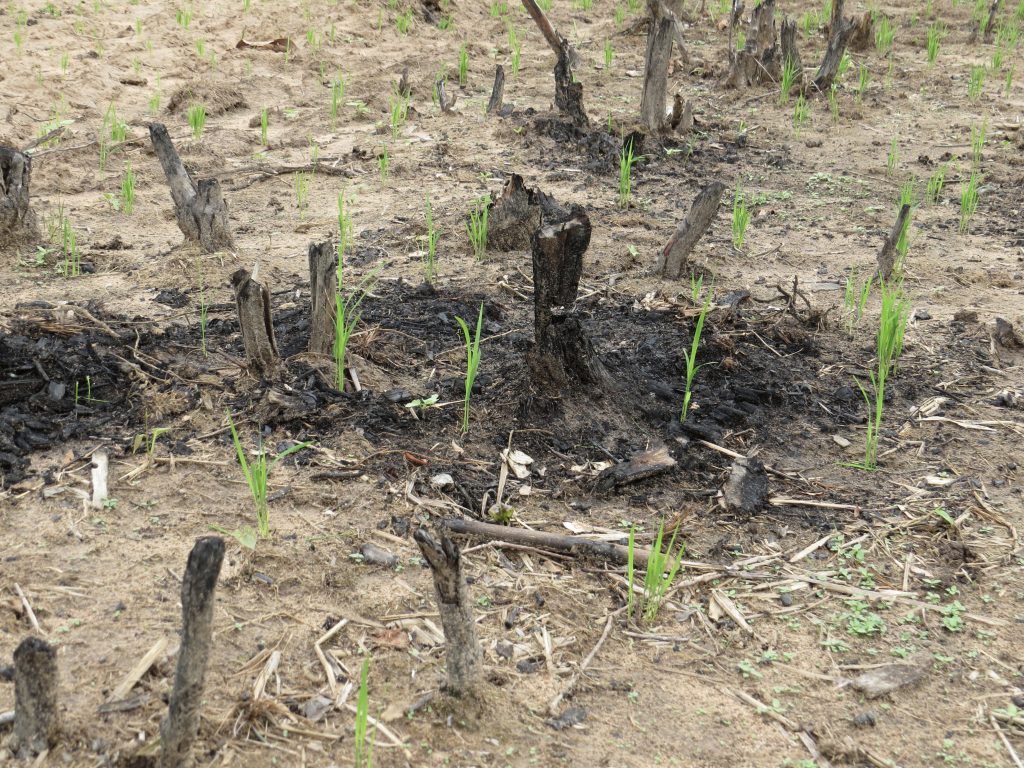
ស្រូវទើបនឹងដុះ 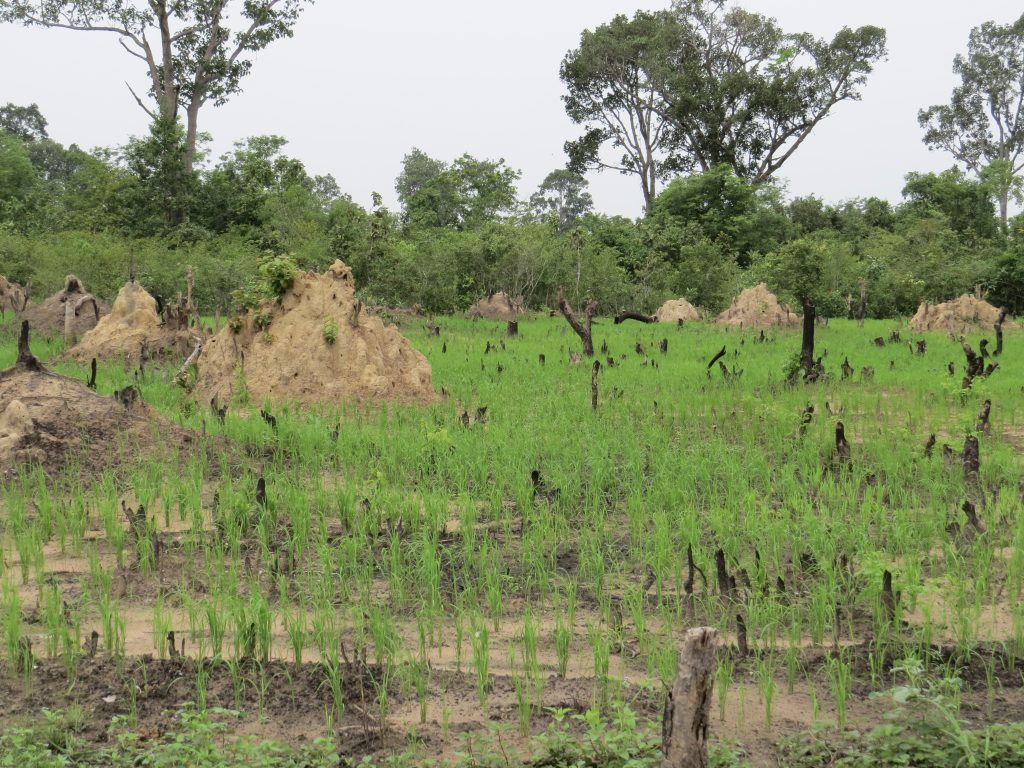
ស្រូវដុះបានមួយរយៈ 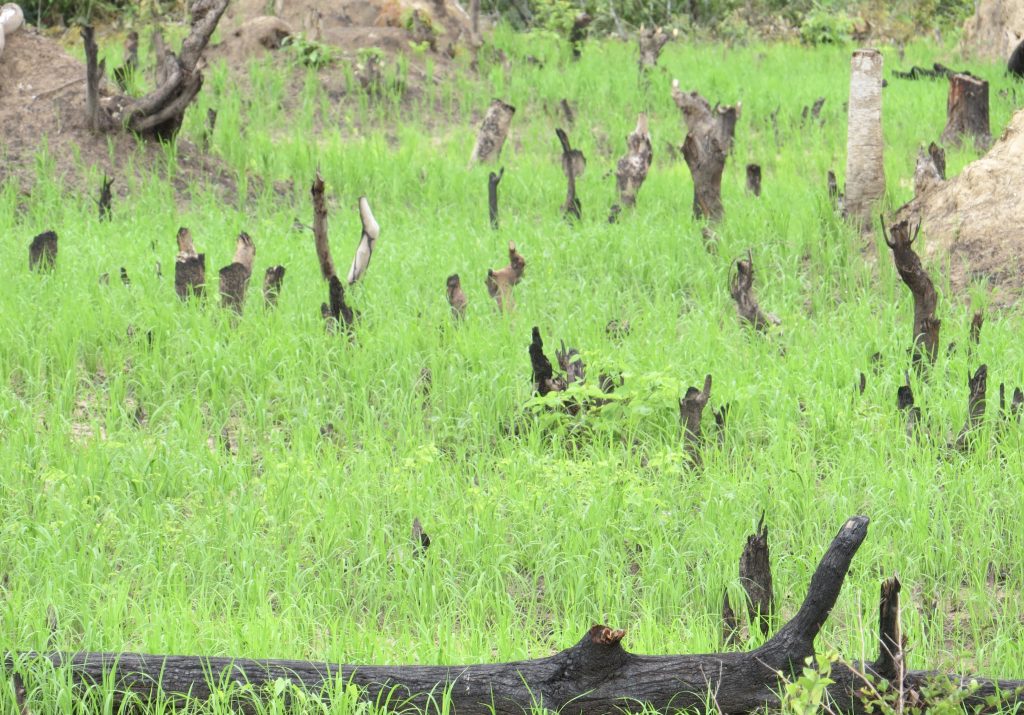
ស្រូវដុះអាចបំបែកបាន
—————————————————
Chreong, one of the planting techniques
Traditional rice-planting techniques are many. It depends on the type of land and the rice seeds. The rice seeds will be planted into the rice field with enough accessible water in the rainy season. Some rice seeds need more time to grow. It is the rice that adapts to water level. This type of rice seeds will plant in a rice field that has a lot of water, and the water should be available for many months.
Another type of rice is called Sruv Chamka. This type of rice seeds will plant on new land that is recently cleared from the woods. The field might remain some roots and tree trunks. Therefore, people use the Chreong technique to plant rice seeds. Chreong or Bok (hit or press) is a planting technique of the minority groups who live in the northeast of Cambodia. Chreong or Bok in Prov minority group’s language is “Chhya Mou Chouy”.
Jesh or Asadha (the month in the lunar calendar) are the months to plant the rice seeds. After planting the rice seeds for several years, the land is good enough to plough because some roots and tree trunks decompose. However, the minority groups tend to change to another land. After two or three years, they would return to the old field. It is called Chamka Vil Chom or Chamka Prei Dut (burn and slash farming). This planting technique belongs to minority groups up to the present.
The way of doing Chreong is the farmer would choose a bamboo in size of the wrist or slightly smaller. It has a sharp end. This stick calls Chheur Chreong (wood for Chreong). The man who hit or press the soil is called Neak Chreong. Neak Chreong holds two Chheur Chreong in both hands and makes the holes about two centimeters deep. He can walk frontward or backwards.
Chreong could be done between the gap of the roots and around the mount where the land is available. It is about 30 to 40 centimeters each. Neak Chreong tends to be the men and women who are the ones to put the seeds in the hole. Hence, each of Neak Chreong could work with four to five women. In the case of a large field, people help one another so they might need four to five Neak Chreongs and ten to twenty women to put the seeds.
Burn and Slash farming has many people involved. Therefore, it is a happy moment. They could tease one another to accelerate the work. In the case holes are close to each other, it is called Anlung Por Kon. Thus, farmers tend to jump from one hole for another. Farmers Chreong the rice seeds within one or two days. It is to make sure the rice seeds grow at the same length.
The most selected seeds for burn and slash farming are Neang Ok or Neang Koun/Neang Kouy, and some rice seeds that require slightly faster or within four to five months are called Sruv Sral. The rice seeds that minority groups choose to Chreong are KaNget, Bvit, Lkorn, Hkal, Tranh, and Kasi. The seeds do not need to soak into the water. During planting rice, some portions of the land could have other crops.
On a planting day, the farmer put the rice seeds into a bamboo about the size of the wrist. This bamboo has to close one side. Also, it uses to push the soil onto the seeds. In four to five days, the seeds could grow in two to three centimeters. During this time, farmers separate the plants and add to other spots where few plants. The separation usually has been done while raining to avoid shrinking or drying. After planting, farmers will take care of the rice until harvest.



